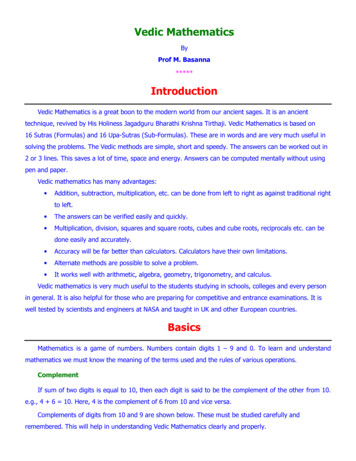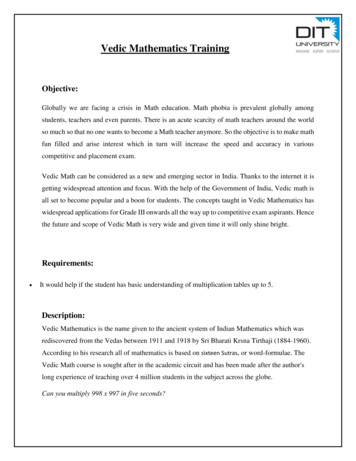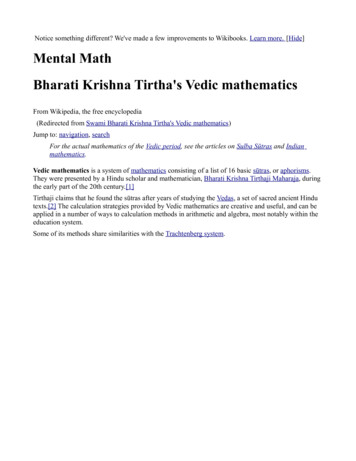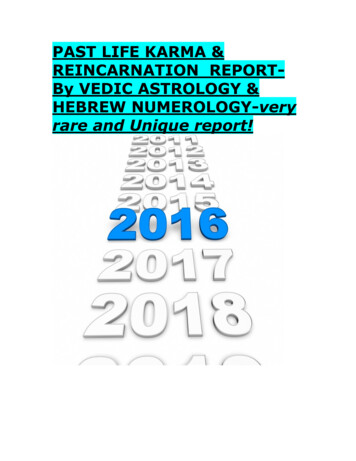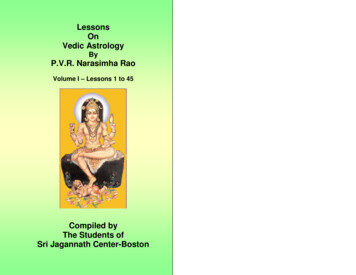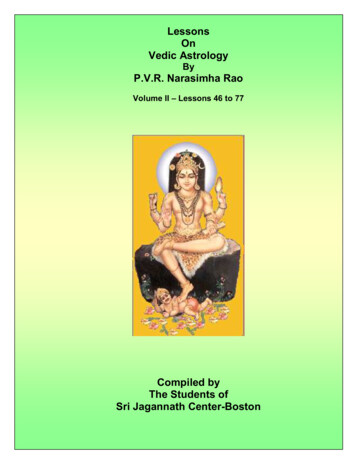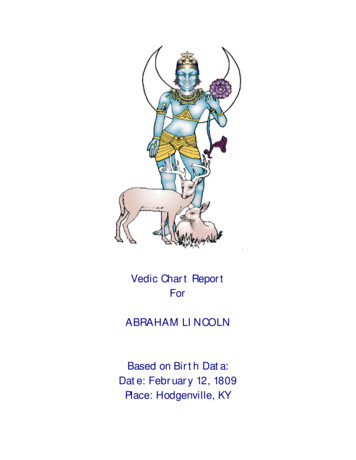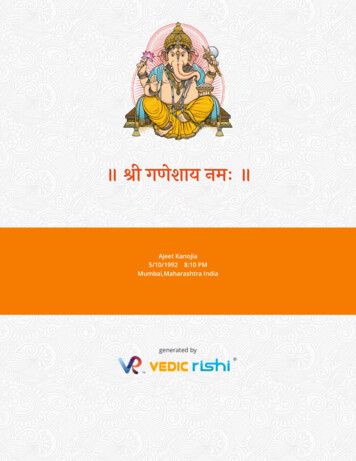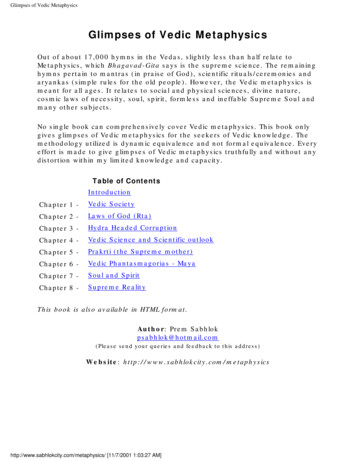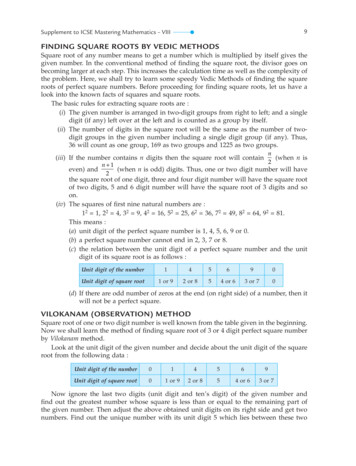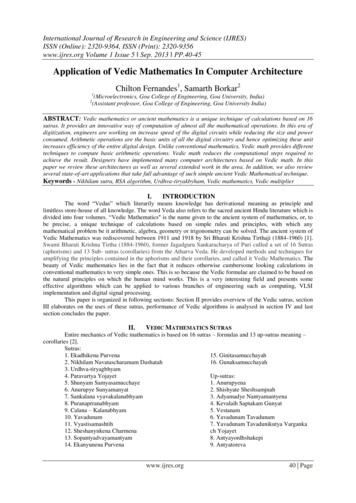
Transcription
International Journal of Research in Engineering and Science (IJRES)ISSN (Online): 2320-9364, ISSN (Print): 2320-9356www.ijres.org Volume 1 Issue 5 ǁ Sep. 2013 ǁ PP.40-45Application of Vedic Mathematics In Computer ArchitectureChilton Fernandes1, Samarth Borkar21(Microelectronics, Goa College of Engineering, Goa University, India)(Assistant professor, Goa College of Engineering, Goa University India)2ABSTRACT: Vedic mathematics or ancient mathematics is a unique technique of calculations based on 16sutras. It provides an innovative way of computation of almost all the mathematical operations. In this era ofdigitization, engineers are working on increase speed of the digital circuits while reducing the size and powerconsumed. Arithmetic operations are the basic units of all the digital circuitry and hence optimizing these unitincreases efficiency of the entire digital design. Unlike conventional mathematics, Vedic math provides differenttechniques to compute basic arithmetic operations. Vedic math reduces the computational steps required toachieve the result. Designers have implemented many computer architectures based on Vedic math. In thispaper we review these architectures as well as several extended work in the area. In addition, we also reviewseveral state-of-art applications that take full advantage of such simple ancient Vedic Mathematical technique.Keywords - Nikhilam sutra, RSA algorithm, Urdhva-tiryakbyham, Vedic mathematics, Vedic multiplierI.INTRODUCTIONThe word “Vedas” which literarily means knowledge has derivational meaning as principle andlimitless store-house of all knowledge. The word Veda also refers to the sacred ancient Hindu literature which isdivided into four volumes. “Vedic Mathematics" is the name given to the ancient system of mathematics, or, tobe precise, a unique technique of calculations based on simple rules and principles, with which anymathematical problem be it arithmetic, algebra, geometry or trigonometry can be solved. The ancient system ofVedic Mathematics was rediscovered between 1911 and 1918 by Sri Bharati Krishna Tirthaji (1884-1960) [1].Swami Bharati Krishna Tirtha (1884-1960), former Jagadguru Sankaracharya of Puri culled a set of 16 Sutras(aphorisms) and 13 Sub- sutras (corollaries) from the Atharva Veda. He developed methods and techniques foramplifying the principles contained in the aphorisms and their corollaries, and called it Vedic Mathematics. Thebeauty of Vedic mathematics lies in the fact that it reduces otherwise cumbersome looking calculations inconventional mathematics to very simple ones. This is so because the Vedic formulae are claimed to be based onthe natural principles on which the human mind works. This is a very interesting field and presents someeffective algorithms which can be applied to various branches of engineering such as computing, VLSIimplementation and digital signal processing.This paper is organized in following sections: Section II provides overview of the Vedic sutras, sectionIII elaborates on the uses of these sutras, performance of Vedic algorithms is analysed in section IV and lastsection concludes the paper.II.VEDIC MATHEMATICS SUTRASEntire mechanics of Vedic mathematics is based on 16 sutras – formulas and 13 up-sutras meaning –corollaries [2].Sutras:1. Ekadhikena Purvena15. Ginitasamucchayah2. Nikhilam Navatascharamam Dashatah16. Gunaksamucchayah3. Urdhva-tiryagbhyam4. Paravartya YojayetUp-sutras:5. Shunyam Samyasamucchaye1. Anurupyena6. Anurupye Sunyamanyat2. Shishyate Sheshsamjnah7. Sankalana vyavakalanabhyam3. Adyamadye Nantyamantyena8. Puranaprranabhyam4. Kevalaih Saptakam Gunyat9. Calana – Kalanabhyam5. Vestanam10. Yavadunam6. Yavadunam Tavadunam11. Vyastisamashtih7. Yavadunam Tavadunikutya Varganka12. Sheshanynkena Charmenach Yojayet13. Sopantyadvayamantyam8. Antyayordhshakepi14. Ekanyunena Purvena9. Antyatorevawww.ijres.org40 Page
Application Of Vedic Mathematics In Computer Architecture10. Samucchayagunitah12. Vilokanam11. Lopanasthapanabhyam13.Gunitasamucchyah samucchayagunitahIn the field of engineering most of the researcher are using following sutras, we will describe them briefly:i) Nikhilam navata charanam Dashatah,ii) Urdhva-tiryakbyham.2.1 Nikhilam SutraFirst formula under consideration is Nikhilam Navatascharam Dashtah which means all from 9 and lastfrom 10. The algorithm has its best case in multiplication of numbers, which are nearer to bases of 10, 100, 1000i.e. increased powers of 10. The procedure of multiplication using the Nikhilam involves minimum mentalmanual calculations, which in turn will lead to reduced number of steps in computation, reducing the space,saving more time for computation. The numbers taken can be either less or more than the base considered. Themathematical derivation of the algorithm is given below. Consider two n-bit numbers x and y to be multiplied.Then their complements can be represented as x1 10n - x and y1 10n – y. The product of the two numberscan be given as p (x, y). Now a factor 102n 10n (x y) is added and subtracted on the right hand side of theproduct equation, which is mathematically expressed as shown below.p xy 102n 10n (x y) - 102n - 10n ( x y)On simplifying we get,p {10n (x y) - 102n} {102n -10n (x y) xy} 10n {(x y) - 10n} {(10n – x) ( 10n – y)} 10n {x – y1} {x1 y1} 10n {y – x1} {x1 y1}From the above equation we can derive the left hand side of the product as {x – y1} or {y– x1} and theright hand side as (x1.y1) The basic operations involved in the algorithm for a given set of numbers are givenbelow.Consider 98 x 97Here the Nearest Base 100Fig 1: Multiplication using Nikhilam sutraResult 98 x 97 9506The Nikhilam Sutra can also be modified for binary arithmetic.2.2 Urdhava TiryakbhyamUrdhava Tiryakbhyam Sutra, which literally means “Vertically and crosswise”, is a generalmultiplication formula applicable to all cases of multiplication. This Sutra highlights parallelism in generation ofpartial products and their summation as depicted in Fig 2. Consider multiplication of 576x324 186624.www.ijres.org41 Page
Application Of Vedic Mathematics In Computer ArchitectureFig: 2 Illustration of vertically and crosswise multiplicationAlternative method for calculation using Urdhva-Triyakhbhyam sutra is shown in figure 3. Let usconsider the multiplication of (5498 2314). The numbers to be multiplied are written on two consecutive sidesof the square as shown in the figure 1. The square is divided into rows and columns where each row/columncorresponds to one of the digit of either a multiplier or a multiplicand. Thus, each digit of the multiplier has asmall box common to a digit of the multiplicand. These small boxes are partitioned into two halves by thecrosswise lines. Each digit of the multiplier is then independently multiplied with every digit of the multiplicandand the two digit product is written in the common box. All the digits lying on a crosswise dotted line are addedto the previous carry. The least significant digit of the obtained number acts as the result digit and the rest as thecarry for the next step. Carry for the first step (i.e., the dotted line on the extreme right side) is taken to be zero.III.Uses of Vedic SutrasVedic mathematics is used by several researchers in the field of Digital signal processing, Chipdesigning, Discrete Fourier Transform , High speed low power VLSI arithmetic and algorithm, RSA encryptionsystem . Most of the researchers have used the Vedic mathematics method such as multiplication, division,squares and cubes in above mention fields.3.1 Multiplier and squarer architectureMathematical operations especially multiplications consumes most of the time of the process in acomputer. High speed multiplication is desired in real-time operations and image processing applications.Various multiplier architectures have been developed using various algorithms such as Booth, array multipliersand Wallace tree. All the aforesaid algorithms use the basic conventional method of multiplication. Vedicmathematics provides an innovative method of multiplication. Vedic multiplication reduces computation timeby parallel generation of intermediate (Urdhviate) products. Multiplier designed using Urdhva-tiryakbyhamsutra of Vedic mathematics is faster than array multiplier and Booth multiplier architecture and is very efficientin silicon area per speed [3, 4, 5]. Another multiplier using Nikhilam sutra of Vedic mathematics shows similarresults when compared to the conventional multipliers [6]. Squarer is designed using the “Duplex” D property ofthe binary numbers and Urdhva-tiryakbyham sutra, is the smallest and fastest as compared to the conventionalmultipliers [7].www.ijres.org42 Page
Application Of Vedic Mathematics In Computer ArchitectureFig 3: Alternative way of multiplication by Urdhva tiryakbhyam Sutra3.2 VLSI Implementation of RSA encryptionRSA is an algorithm for public-key cryptography for network security. One of the most timeconsuming processes in RSA algorithm is computing ab mod n where ‘a’ is the text and (b, n) is the public key.Dhvanjanka sutra is used in RSA encryption and decryption algorithm. RSA implemented using the overlayhierarchical multiplier architecture and division architecture using Dhvajanka sutra of Vedic mathematicsreduces computation time and reduces delay greatly as compared to the RSA implemented using traditionalmultipliers and division algorithms [8, 9].3.3 Discrete Fourier TransformThere are many algorithms for finding DFT. But now a day’s only VON-NEUMAN architecturalimplementation of classical method is found to be used in digital computers. Kulkarni analyses and comparesthe Implementation of Discrete Fourier Transform algorithm by existing and by Vedic mathematics techniques[10]. He suggested that architectural level changes in the entire computation system to accommodate the VedicMathematics method increases the overall efficiency of DFT procedure.3.4 FFT ImplementationA fast Fourier transform (FFT) is an algorithm to compute the discrete Fourier transform (DFT) andit’s inverse. FFT is widely used in wireless communication imaging etc. Implementation of FFT requires largenumber of complex multiplications and complex additions, so to make this process rapid and simple it’snecessary for a multiplier to be fast and power efficient. Vedic mathematics is an efficient method ofmultiplication.Nidhi Mittal and Abhijeet Kumar implemented FFT using “Vertically and crosswise” algorithm ofVedic maths and suggested that Vedic mathematics reduces the complex number multiplications and additionsfrom N2 to N/2log2N and Nlog2N respectively and conclude that Vedic method is faster than the arraymultiplier architecture [11, 12, 13].3.5 ALU DesignArithmetic and logic unit is at the heart of the digital circuits. Due to the complexity of the operationsthat needs to be performed nowadays by the processor, the demand for sharing the load by many special purposeprocessors is increased. Hence the speed, size and power efficiency of the ALU becomes important factors whendesigning an ALU. Use of Vedic mathematics for multiplication strikes a difference in actual process and hencewww.ijres.org43 Page
Application Of Vedic Mathematics In Computer Architecturereduces size and power. Anvesh kumar used Urdhva tiryakbhyam Sutra of Vedic mathematics to build a powerefficient multiplier in the coprocessor [14]. The advantages of Vedic multipliers are increase in speed, decreasein delay, decrease in power consumption and decrease in area occupancy. It is stated that this Vedic coprocessoris more efficient than the conventional one.3.6 Elliptic curve cryptographyElliptic curve cryptography (ECC) is an approach to public-key cryptography based on the algebraicstructure of elliptic curves over finite fields. Like the RSA, EEC is also a public key encryption. The mostimportant equation that needs to be solved in ECC curve equations are y2 xy x3 ax2 b (Weierstrass equationin GF(2m)) and y2 x3 ax b (Weierstrass equation in GF(p)). The major time consuming arithmetic operationsoperation in ECC are point additions and doubling as exponentiation operations like square, cube and fourthpower occur in these operations. Thapliyal et.al proposed a novel square and fourth power computation usingVedic mathematics algorithm [16]. A considerable input in the point addition and doubling has been observedwhen implemented using proposed techniques for exponentiation.IV.Performance Analyses of Vedic AlgorithmsVarious parameters are recommended by researchers to evaluate the performance of Vedic Mathsalgorithm. Researchers suggested many parameters few of them are: Time, Delay, Power and Number of slices.The comparison of Delay (ns) factor for multiplication implemented in different algorithms betweenConventional and Vedic way is shown in Table 1 [15].V.ConclusionVedic mathematics formulae can be used in various algorithms in different computer applications.Various parameters are considered for comparisons of different algorithms. It is concluded that the computerarchitectures designed using Vedic mathematics are proved to better the conventional architecture in terms ofcomputation speed, power utilisation and silicon area. Various algorithm based on Vedic maths proved to havefaster speed, less power and lesser area. The results obtained are also verified on various FPGAs. Furtherimprovement can be done by reducing the delay caused by propagation of the carry generated from theintermediate products in the multipliers.Sr. No.Implemented in01VLSI Implementation of High PerformanceRSA Algorithm02ConventionalVedic8 bit16 bit8 bit16 460.64615.19323.6001327.809542.3251207.677High Speed Energy Efficient ALU Design3An Efficient Method of EllipticCurve Encryption ( for square)430.370An Efficient Method of Elliptic CurveEncryption ( for point doubling)604.861Table 1: Comparisons of differen
Vedic maths and suggested that Vedic mathematics reduces the complex number multiplications and additions from N2 to N/2log2N and Nlog2N respectively and conclude that Vedic method is faster than the array multiplier architecture [11, 12, 13]. 3.5 ALU Design Arithmetic and logic unit is at the heart of the digital circuits. Due to the complexity of the operations that needs to be performed .


